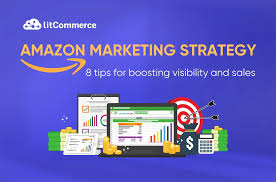
With millions of sellers competing for customer attention on Amazon, standing out requires more than just listing products. Effective marketing is the key to driving traffic, increasing conversions, and maximizing profits. Amazon Marketing Services provides sellers with a powerful suite of advertising tools to promote their products and gain an edge over the competition.
In this article, we will explore Amazon Marketing Services in-depth, discuss its key features, benefits, and strategies for leveraging these tools to enhance brand visibility and sales.
What is Amazon Marketing Services (AMS)?
Amazon Marketing Services (AMS) is a suite of paid advertising solutions that help sellers promote their products within Amazon’s marketplace. These services include various ad formats and campaign options designed to improve visibility and drive sales. AMS is particularly beneficial for brands, private-label sellers, and vendors looking to dominate their niche and outperform competitors.
Amazon offers multiple advertising solutions under AMS, including:
-
Sponsored Products
-
Sponsored Brands
-
Sponsored Display
-
Amazon DSP (Demand-Side Platform)
Each of these ad types serves a different purpose, allowing sellers to target customers at various stages of the purchasing journey.
Key Features of Amazon Marketing Services
1. Sponsored Products
Sponsored Products ads promote individual listings and appear in Amazon search results and product pages. These ads operate on a pay-per-click (PPC) model, where sellers bid on keywords relevant to their products. This feature helps increase visibility for specific items, drive traffic, and boost sales.
2. Sponsored Brands
Sponsored Brands (formerly known as Headline Search Ads) are designed for brand awareness. These ads appear at the top of search results and include a brand logo, custom headline, and multiple products. Sponsored Brands are ideal for companies looking to establish a strong brand presence on Amazon.
3. Sponsored Display
Sponsored Display ads target shoppers based on their browsing and purchasing behavior. These ads appear on Amazon and third-party websites, helping sellers re-engage potential customers who have viewed their products but haven’t completed a purchase.
4. Amazon DSP (Demand-Side Platform)
Amazon DSP allows sellers to programmatically buy display and video ads on and off Amazon. This solution is best for brands with larger advertising budgets that want to expand their reach beyond the Amazon marketplace.
Benefits of Using Amazon Marketing Services
1. Increased Product Visibility
With millions of products on Amazon, it’s easy for listings to get lost. AMS ensures that your products appear prominently in search results, increasing exposure to potential buyers.
2. Higher Conversion Rates
AMS ads target shoppers who are actively searching for similar products. This means your ads are shown to people who are already interested, resulting in higher conversion rates.
3. Precise Targeting Options
Amazon allows sellers to refine their advertising strategy with keyword targeting, product targeting, audience segmentation, and retargeting. This precision ensures that ads are displayed to the most relevant audience.
4. Scalability
AMS provides flexible advertising options that can be scaled according to your business size and budget. Whether you’re a small business or a large brand, you can adjust your campaigns to meet your goals.
5. Cost-Effective Advertising
Since AMS operates on a pay-per-click model, you only pay when someone clicks on your ad. This ensures that your advertising budget is spent efficiently on genuine potential buyers.
6. Detailed Analytics and Reporting
Amazon provides detailed campaign performance metrics, allowing sellers to track ROI, optimize bids, and refine their marketing strategies for better results.
Best Practices for Amazon Marketing Services
1. Conduct Thorough Keyword Research
Choosing the right keywords is crucial for AMS success. Use Amazon’s search term reports, third-party tools, and competitor analysis to identify high-converting keywords.
2. Optimize Product Listings
Before launching an ad campaign, ensure your product listings are fully optimized. This includes using high-quality images, compelling product descriptions, and relevant keywords.
3. Use Automatic and Manual Campaigns
Start with automatic campaigns to gather data on which keywords perform best. Then, create manual campaigns with targeted bids on the highest-performing keywords.
4. Monitor and Adjust Bids Regularly
Regularly analyze campaign performance and adjust bids based on conversion rates and cost-per-click (CPC) trends.
5. Leverage A/B Testing
Test different ad creatives, headlines, and keywords to determine what works best for your audience.
6. Retarget Potential Customers
Use Sponsored Display and Amazon DSP to retarget shoppers who viewed your products but didn’t complete a purchase. Retargeting helps increase conversion rates and maximize ad spend efficiency.
7. Optimize for Mobile Shoppers
A significant portion of Amazon shoppers use mobile devices. Ensure that your ads and product listings are optimized for mobile viewing.
Challenges of Amazon Marketing Services
While AMS offers numerous benefits, there are some challenges that sellers should be aware of:
1. High Competition
Amazon’s marketplace is highly competitive, and bid prices for popular keywords can be expensive. Sellers must strategically manage their budget and bidding strategy to remain profitable.
2. Constant Monitoring Required
AMS campaigns require continuous monitoring and optimization to ensure they remain effective. Sellers must stay updated with Amazon’s algorithm changes and advertising policies.
3. Ad Fatigue
Customers may become immune to repeated ads. To combat this, sellers should update ad creatives, test new headlines, and rotate product selections regularly.
Conclusion:
While Amazon Marketing Services can drive traffic and boost sales, its effectiveness depends heavily on Amazon Listing Optimization. A well-optimized listing with clear images, engaging descriptions, and strategic keyword placement ensures that the traffic from AMS campaigns converts into actual sales.
To maximize success, sellers should continuously refine their product listings, monitor ad performance, and adjust their marketing strategies. By integrating AMS with listing optimization, sellers can create a powerful, results-driven approach to Amazon success.
Whether you’re new to AMS or looking to enhance your current campaigns, following these best practices will help you achieve higher visibility, increased conversions, and sustained growth on Amazon